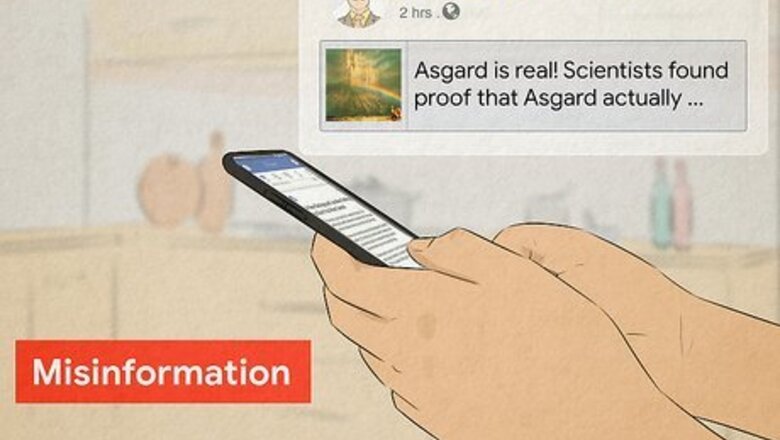
views
Definitions
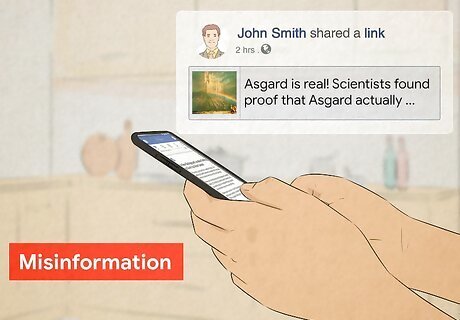
Identify misinformation as any false information spread as truth. Plenty of people share false information while fully believing they’re spreading the truth to their friends and family. This phenomenon is known as “misinformation,” and is far more common than you may think. If a person isn’t actively fact-checking their sources before sharing new info, they could be sharing misinformation without even realizing it. While this isn’t ideal, the person posting probably didn’t mean any harm. If someone shares an unverified news article believing it to be fact, they might be spreading misinformation, but they don't know it. Some misinformation is misleading but not false by implying a link between two unrelated claims. For example, "Joe Biden is president and there are more than 50,000 coronavirus deaths in the US" is misleading; while Joe Biden is president (as of February 2021), and there are more than 50,000 coronavirus deaths in the US, there is no correlation between these two claims.
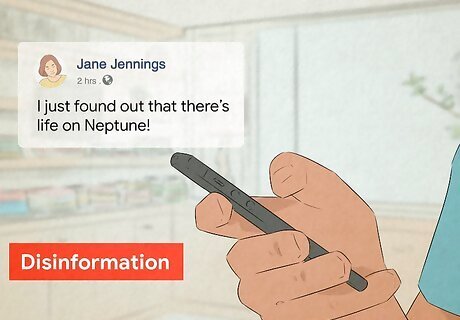
Know that disinformation is false information spread with malicious intent. While misinformation can be spread with positive, helpful intent, disinformation is designed to deceive and manipulate the reader or viewer. When an organization or individual deliberately creates and shares false facts, they’re partaking in “disinformation.” Try to remember it like this: misinformation is often a mistake, while disinformation is deliberate. If someone deliberately creates and shares a false narrative, they’re participating in disinformation.
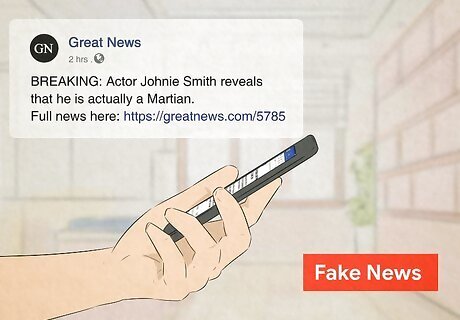
Recognize that fake news is false information spread by news sources. Fake news is an umbrella term that includes both misinformation and disinformation. However, fake news involves spreading misinformation and disinformation on a wide scale or platform and presenting it as real news. Fake news is especially dangerous since it has the potential to reach a lot of different people. Fake news is usually spread by special “fake-news outlets,” which are separate organizations and websites designed to spread false, fabricated information.
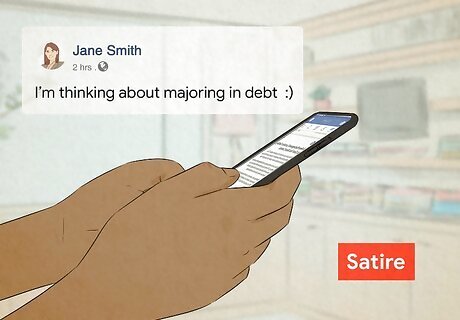
Define satire as excessive misinformation designed to prove a point. Satire and parody articles offer a bit of gray area in the misinformation/disinformation debate. Unlike actual misinformation, satire articles are designed to be outlandishly false in order to prove a particular point. However, if someone mistakenly shares a satire or parody article and presents it as fact, then they’re spreading misinformation. For instance, an example of a satire article could be something like: “COVID-19 Originated on Mars.” If someone takes this article seriously and shares it with others, then they’re actively spreading misinformation. A satire article might raise awareness about how bizarre certain COVID-19 stereotypes are.
Fact-Checking Claims
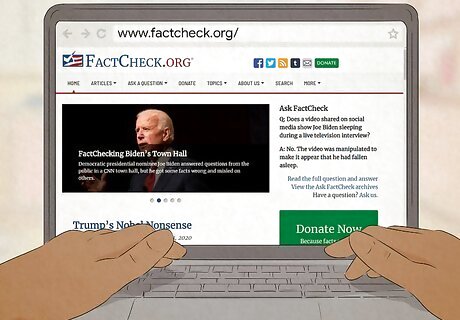
Clarify misinformation and disinformation with fact-checking sites. It really is a jungle out there when it comes to false facts and the rest of the internet. Thankfully, there are a lot of great resources available that can help you stay up-to-date on the facts. Search for new claims on a fact-checking site to find out if the information is accurate. You can find lists of different fact-checking websites at https://research.ewu.edu/journalism/factcheck and https://en.wikipedia.org/wiki/List_of_fact-checking_websites.
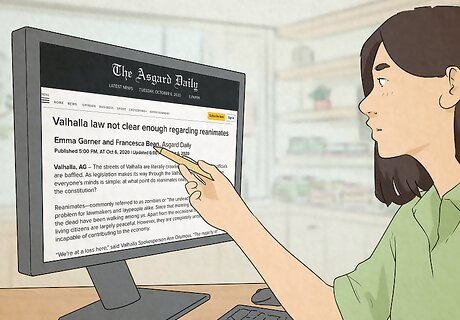
Scan over the website to see if it’s legit. Find the “about” page on the website—most reputable news organizations will have one. Read through the site description to see if there’s an obvious bias, which can be a red flag. Additionally, look for photos and bios for their staff, as some fake-news outlets will use stock photos to make their site seem more legit. Another good thing to check is the website URL itself, as many fake-news outlets will try to pass their site off as an official URL. For instance, a fake-news site might have the URL “cbsnews.com.co,” which is obviously fake and not the real CBS news. If a site doesn’t have an “about” or “contact” page, you can assume it’s a fake-news site. You can save an image and reverse-search it to see if it’s a stock photo. Some outlets will also use “false” photos to generate hype for their fake stories. Bias can be incorporated in a lot of ways. Usually, it’s seen through extra bits of unnecessary writing that feeds on stereotypes and political agendas.

Double-check the date the article was published. Some fake news groups will reference old headlines and sound bytes and repurpose them for the current climate. Compare the date of the article to the dates of the sources the article is referencing. You may be surprised at how much fake news can spread this way! For instance, a fake news article may write a story about the apocalypse, but reference an article about apocalypse claims from 2012.

Do a background check on the author and their references. Research may seem like an annoying extra step, but it doesn’t take as long as you think. Look for the name of the article’s author and give them a quick search online. Additionally, look for any sources that the article references in the text. A well-researched, factual article will be supported by the facts, and will be written by an educated individual. Ideally, you’re looking for an author who’s written similar articles for well-established organizations. If the referenced sources don’t back up the article content, then you’re likely reading a fake news piece.
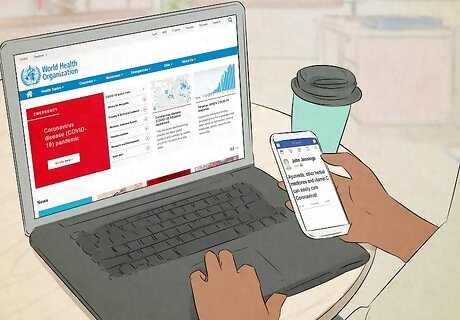
Compare the article to a well-established source. Search the general article against highly-regarded, well-informed sources. Cross-check the information from the article or news report and see if it lines up with what the experts are saying. If the article seems to contradict expert findings, then you can safely assume it’s a fake news article. For instance, if you’re cross-checking an article on COVID-19, you’d want to reference it against reputable sources like the United Nations and the World Health Organization.
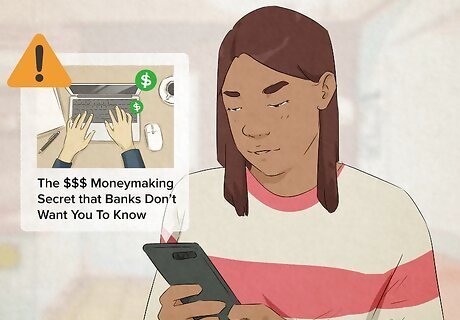
Don’t be fooled by articles with clickbait titles. As the name suggests, clickbait articles are enticing titles that aim to lure the reader into “clicking” onto the article. Unfortunately, clickbait is often used to entice readers onto fake news articles. Studies show that 60% of users on social media will share an article without actually perusing the content themselves. If you stumble across a headline that seems too ludicrous to be true, keep scrolling instead. Articles with titles like “You Won’t Believe This Happened” are good examples of clickbait.

Avoid fake news by reading new information with a skeptic attitude. It may seem a bit negative, but you can protect both yourself and others by reading new information with a more critical eye. Don’t treat any information as fact until you’ve checked the author, website, and sourcing for credibility. It can be a bit time-consuming, but it can save you a lot of trouble in the long run. Remind your friends and family to view news reports more critically, too.


















Comments
0 comment